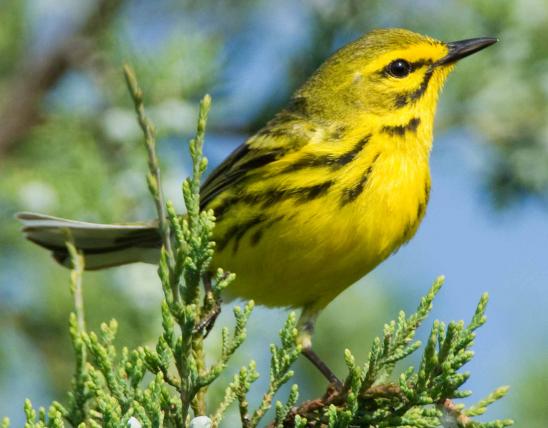
The adult yellow warbler male is all yellow, with reddish streaks on breast and yellow spots in tail. Female is duller yellow, with faint streaking on breast. Song is a whistled phrase that goes down and up at the end: seet-seet-seet-seet-su-ee, many birders learn it as sweet-sweet-sweet-I'm-so-sweet. Call is a sweet chip.
Similar species: American goldfinches have the thick, conical bills characteristic of finches; breeding males are brighter yellow and have a black cap, black wings, and black tail. The female yellow warbler can be confused with some other female warblers, such as the common yellowthroat and Wilson’s, hooded, and orange-crowned warblers; to ID female yellow warblers, look for yellow patches in the tail, a fairly large bill (for a warbler), evenly yellow coloration, and the fact that yellow warblers are near the crowns of trees and shrubs, not close to the ground.
Length: 5 inches.

Statewide.
Habitat and Conservation
In spring and early fall, migrants are commonly seen in shrubs in wetlands, along streams, in parks, and in backyards, foraging on insects. Usually found near water. In summer, look for breeding residents along larger rivers and streams and in willow marshes. Yellow warblers typically hunt for insects among leaves near the tops of small trees and larger shrubs. Birders usually seek warblers first with their ears, listening for the distinct song, and then search with binoculars for the singer.
Food
Yellow warblers are active foragers, hopping along small branches and flitting among leaves of trees, plucking caterpillars, beetles, bugs, and other insects from leaves. Many of the insects they help control are pests of forest trees. As insect-eaters, they don’t visit birdfeeders.
Status
Common migrant statewide. As summer breeding resident, common in northern Missouri, rare in southern Missouri. The global population is declining, mainly due to habitat loss but also to habitat fragmentation, which increases their nests’ exposure to brown cowbirds; these nest parasites reduce the breeding success of many birds that usually breed far from open areas. Genus name: This and nearly 30 other wood-warblers used to be in the genus Dendroica, but evidence from genetic research showed that the genus could not logically be kept separate from genus Setophaga. Today, all the Dendroica warblers are in genus Setophaga.
Life Cycle
In a small tree, females build a cup nest out of grasses and other fine plant material weaving it together with spider web and other soft fibers and lining it with soft materials such as deer hair and fluff from cottonwood, milkweed, and cattail seeds. Clutches contain 1–7 eggs, which are incubated 10–13 days. After hatching, the young remain in the nest for another 9–12 days. There can be 1 or 2 broods a year. Yellow warblers can live for at least 11 years. This species breeds across almost all of North America and spends winters in Central America and the northern portion of South America. They’re present in Missouri April through September. Birds in eastern North America fly nonstop, clear across the Gulf of Mexico.
Human Connections
In the pages of a field guide, this and other bright yellow warblers would seem to be some of the most colorful birds in the world. But when you’re looking for them high in trees, amid thousands of chartreuse-yellow leaves backlit by the sun, you realize this bright coloration functions as a perfect camouflage. Birders learn to listen for the song and watch for the bird’s movements.
Ecosystem Connections
Female brown-headed cowbirds often lay their eggs in the nests of yellow warblers. Cowbirds parasitize the nests of many species, often preventing the young of those species from surviving, but yellow warblers have developed an adaptive response to this parasitism: When a yellow warbler detects a cowbird egg it its nest, it either abandons the nest (including its own possibly doomed eggs), or it builds another nest on top of it, effectively stopping the incubation of the cowbird egg. Several nests may be stacked on top of each other, each one with some of the warbler’s and one of the cowbird’s eggs.






About 350 species of birds are likely to be seen in Missouri, though nearly 400 have been recorded within our borders. Most people know a bird when they see one — it has feathers, wings, and a bill. Birds are warm-blooded, and most species can fly. Many migrate hundreds or thousands of miles. Birds lay hard-shelled eggs (often in a nest), and the parents care for the young. Many communicate with songs and calls.



























